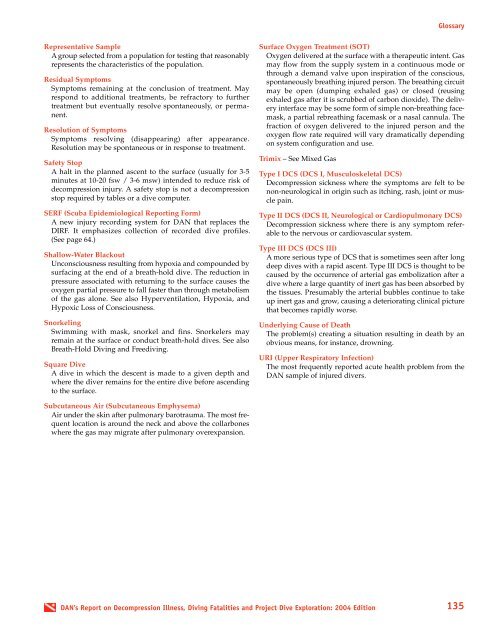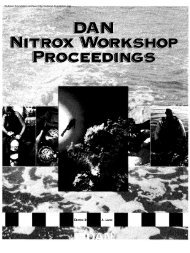Report on Decompression Illness, Diving Fatalities and Project Dive
Report on Decompression Illness, Diving Fatalities and Project Dive
Report on Decompression Illness, Diving Fatalities and Project Dive
- No tags were found...
You also want an ePaper? Increase the reach of your titles
YUMPU automatically turns print PDFs into web optimized ePapers that Google loves.
GlossaryRepresentative SampleA group selected from a populati<strong>on</strong> for testing that reas<strong>on</strong>ablyrepresents the characteristics of the populati<strong>on</strong>.Residual SymptomsSymptoms remaining at the c<strong>on</strong>clusi<strong>on</strong> of treatment. Mayresp<strong>on</strong>d to additi<strong>on</strong>al treatments, be refractory to furthertreatment but eventually resolve sp<strong>on</strong>taneously, or permanent.Resoluti<strong>on</strong> of SymptomsSymptoms resolving (disappearing) after appearance.Resoluti<strong>on</strong> may be sp<strong>on</strong>taneous or in resp<strong>on</strong>se to treatment.Safety StopA halt in the planned ascent to the surface (usually for 3-5minutes at 10-20 fsw / 3-6 msw) intended to reduce risk ofdecompressi<strong>on</strong> injury. A safety stop is not a decompressi<strong>on</strong>stop required by tables or a dive computer.SERF (Scuba Epidemiological <str<strong>on</strong>g>Report</str<strong>on</strong>g>ing Form)A new injury recording system for DAN that replaces theDIRF. It emphasizes collecti<strong>on</strong> of recorded dive profiles.(See page 64.)Shallow-Water BlackoutUnc<strong>on</strong>sciousness resulting from hypoxia <strong>and</strong> compounded bysurfacing at the end of a breath-hold dive. The reducti<strong>on</strong> inpressure associated with returning to the surface causes theoxygen partial pressure to fall faster than through metabolismof the gas al<strong>on</strong>e. See also Hyperventilati<strong>on</strong>, Hypoxia, <strong>and</strong>Hypoxic Loss of C<strong>on</strong>sciousness.SnorkelingSwimming with mask, snorkel <strong>and</strong> fins. Snorkelers mayremain at the surface or c<strong>on</strong>duct breath-hold dives. See alsoBreath-Hold <strong>Diving</strong> <strong>and</strong> Freediving.Square <strong>Dive</strong>A dive in which the descent is made to a given depth <strong>and</strong>where the diver remains for the entire dive before ascendingto the surface.Surface Oxygen Treatment (SOT)Oxygen delivered at the surface with a therapeutic intent. Gasmay flow from the supply system in a c<strong>on</strong>tinuous mode orthrough a dem<strong>and</strong> valve up<strong>on</strong> inspirati<strong>on</strong> of the c<strong>on</strong>scious,sp<strong>on</strong>taneously breathing injured pers<strong>on</strong>. The breathing circuitmay be open (dumping exhaled gas) or closed (reusingexhaled gas after it is scrubbed of carb<strong>on</strong> dioxide). The deliveryinterface may be some form of simple n<strong>on</strong>-breathing facemask,a partial rebreathing facemask or a nasal cannula. Thefracti<strong>on</strong> of oxygen delivered to the injured pers<strong>on</strong> <strong>and</strong> theoxygen flow rate required will vary dramatically depending<strong>on</strong> system c<strong>on</strong>figurati<strong>on</strong> <strong>and</strong> use.Trimix – See Mixed GasType I DCS (DCS I, Musculoskeletal DCS)Decompressi<strong>on</strong> sickness where the symptoms are felt to ben<strong>on</strong>-neurological in origin such as itching, rash, joint or musclepain.Type II DCS (DCS II, Neurological or Cardiopulm<strong>on</strong>ary DCS)Decompressi<strong>on</strong> sickness where there is any symptom referableto the nervous or cardiovascular system.Type III DCS (DCS III)A more serious type of DCS that is sometimes seen after l<strong>on</strong>gdeep dives with a rapid ascent. Type III DCS is thought to becaused by the occurrence of arterial gas embolizati<strong>on</strong> after adive where a large quantity of inert gas has been absorbed bythe tissues. Presumably the arterial bubbles c<strong>on</strong>tinue to takeup inert gas <strong>and</strong> grow, causing a deteriorating clinical picturethat becomes rapidly worse.Underlying Cause of DeathThe problem(s) creating a situati<strong>on</strong> resulting in death by anobvious means, for instance, drowning.URI (Upper Respiratory Infecti<strong>on</strong>)The most frequently reported acute health problem from theDAN sample of injured divers.Subcutaneous Air (Subcutaneous Emphysema)Air under the skin after pulm<strong>on</strong>ary barotrauma. The most frequentlocati<strong>on</strong> is around the neck <strong>and</strong> above the collarb<strong>on</strong>eswhere the gas may migrate after pulm<strong>on</strong>ary overexpansi<strong>on</strong>.DAN’s <str<strong>on</strong>g>Report</str<strong>on</strong>g> <strong>on</strong> Decompressi<strong>on</strong> <strong>Illness</strong>, <strong>Diving</strong> <strong>Fatalities</strong> <strong>and</strong> <strong>Project</strong> <strong>Dive</strong> Explorati<strong>on</strong>: 2004 Editi<strong>on</strong> 135
















